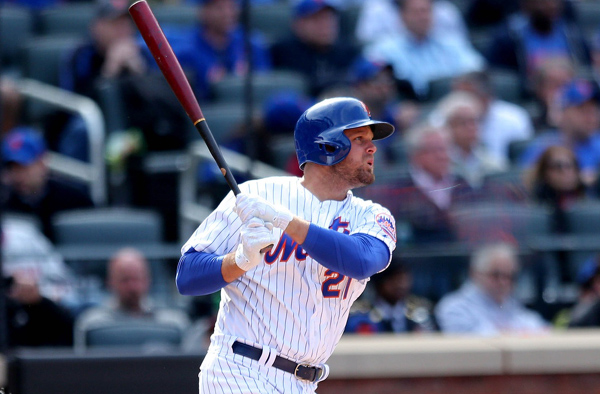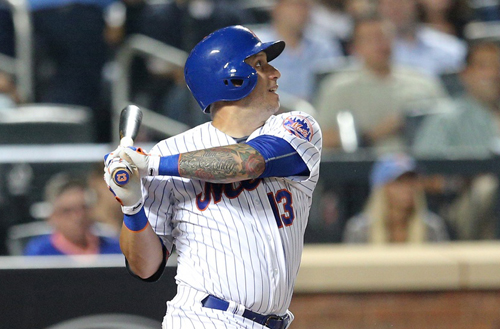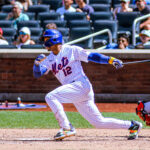
When I was a kid, I was told to never hit a fly ball. Fly balls lead to outs and ground balls lead to more scenarios where the fielder commits an error, or so what I was led to believe. Recently, more hitters are realizing how bad it is to hit a grounder. Virtually nothing good comes from hitting a ground ball outside of the occasional misplay or error. Hitting more balls in the air means more home runs and more runs on the scoreboard.
J.D. Martinez had provided a rather candid piece to FanGraphs about hitting more balls in the air (I caution it is PG-13). Martinez said, “I’m trying to hit the ball in the air. I feel like the ball in the air is my strength and has a chance to go anywhere in the park. So why am I trying to hit a ground ball? That’s what I believe in.” The results showed for Martinez as he produced a .251/.300/.387 slash-line and a 88 wRC+ from 2011-2013 but a .299/.357/.540 slash-line 145 wRC+ from 2014-2016.
Mike Petriello also wrote a great piece asking hitters as to why they were hitting more home runs. One of the best quotes came from former Met, Justin Turner. Turner said, “If I fly out four times, I had a great night, because I didn’t hit a ground ball.” Hitting ground balls is a kiss of death for some hitter. With so many shifts in baseball, you are not likely to produce much from ground ball. Stats showed that in 2016, hitters only produced a 27 wRC+ on ground balls as opposed to a 135 wRC+ on fly balls. Jose Altuve, one of baseball’s best contact hitters, also added, “Last year, I lost my fear to strike out.” I’ve had many conversations about striking out, striking out is not the worst outcome and it can make players better hitters.
The Mets are one of the biggest believers in more fly balls, less grounders, and being more patient. This in large part due to hitting coach, Kevin Long, and director of baseball research and development, T.J. Barra. Over the past few seasons, many Mets hitters have began to embrace this approach rather than always trying to attack. To quote Brad Pitt from Moneyball, “Everyone wants to attack. Quit trying to attack. Let the game come to you man, there’s no clock on this thing. This is a war of attrition.”
The most notable of these hitters was Daniel Murphy. Murphy pulled the more in 2015 and 2016. He also started hitting more balls in the airs those 2 seasons. This culminated in a year where he had a ground ball to fly ball ratio of .87. His fly ball rate was at a career high 41.9% and he pulled the ball at a rate of 41.3%.

I wrote about the changes Neil Walker made to his game already but his double play partner, Asdrubal Cabrera, had an even more drastic change in approach. Cabrera had the month of his career in September and that might not have been by accident. Cabrera hit only 28.3% of balls on the ground that month, the lowest for the 2016 season was Brandon Belt and his 26.3% ground ball rate. Cabrera also pulled the ball 50% of the time. Combine that with his low ground ball rate and you have a lot more homers.
These changes don’t just need to be for average hitters who suddenly turn into legitimate threats at the plate. Curtis Granderson and Yoenis Cespedes changed their approaches at the plate after joining the Mets. Neither made drastic changes to their swings but both of them started laying off bad pitches and drew more walks after becoming Mets.
Granderson only swung at 19.9% and 20.9% of pitches outside of the zone over the last 2 seasons. Those are some of the lowest numbers he’s posted in that department over his career. There were only 5 guys in baseball who swung at fewer pitches out of the zone than Granderson: Dexter Fowler, Carlos Santana, Jose Bautista, Ben Zobrist, and Joey Votto. Cespedes took note of Granderson’s discipline and followed suit. He only swung at 33.1% pitches as opposed to the previous season where he swung at 37.5% of pitches out of the zone.
Jay Bruce is a player who is trying to follow the Mets model. Bruce knows his limitations, saying, “If I didn’t hit a ground ball all year, I’d be in good shape.” Bruce also wants hit 50% of his batted balls in the air, which would be the highest in baseball and the highest of his career. I am far from a Bruce fan but if he accomplishes these goals while laying off more pitches, then I will be a very happy Mets fan.
Kevin Long has worked with Michael Conforto and Travis d’Arnaud this spring to help them with their swing and there are more who can generate more power with Long’s help. A few of these guys are T.J. Rivera, Juan Lagares, and Wilmer Flores. All of these players have some flaw in their game but can conceivably hit for power with some work. Lagares needs to work on his launch angle and hitting more balls in the air. Rivera needs to layoff more pitches outside of the zone and needs to hit more balls in the air. Flores already hits for a lot of power thanks in large part to his prowess against left handers. In 2016 however, he showed some progress against righties too. He hit had a fly ball rate of 40.5% against righties combined with a 40.5% pull rate against them too. He has the right approach against them, maybe a slight tweak and the Mets could have something special with him.
Analytics are helping hitters improve their play. Daniel Murphy put it best, “With all the data we have now, we’ve been kind of given some of the answers to the test.” Hopefully the Mets use these “answers” more and head to the playoffs for the third straight year.















